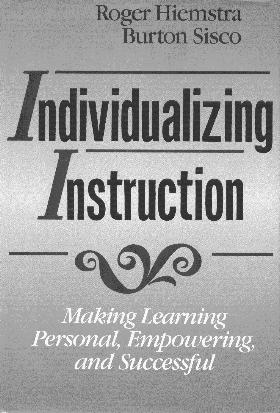 Roger
Hiemstra and Burt Sisco
Roger
Hiemstra and Burt Sisco
 Roger
Hiemstra and Burt Sisco
Roger
Hiemstra and Burt Sisco
Copyright © 1990 by: Jossey-Bass Inc., Publishers, 350 Sansome Street, San Francisco, California 94104 & Jossey-Bass Limited, Headington Hill Hall, Oxford OX3 0BW
Copyright under International, Pan American, and Universal Copyright Conventions. All rights reserved. No part of this book my be reproduced in any form--except for brief quotation (not to exceed 1,000 words) in a review or professional work--without permission in writing from the publishers.
As this book is now out of print, a reverting of the rights to the authors is being sought. Permission to reproduce an adapted version of the book on this web site has been granted.
ISBN 1-55542-255-1
Index
Preface (Introductory Comments)
The Authors (Description of Authors)
Part One: A Personalized Approach to Adult Instruction
Chapter One: How Adult Learning and Achievement Can Be Enhanced
Why an Individualizing Strategy for Adult Learners?
Educational Changes
Theories About Adult Instruction and Learning
Why Individualizing Instruction Makes a Difference
Chapter Two: Learners in Adulthood: Why They're Not Just Big Kids
Mental Characteristics
Physical Characteristics
Emotional Characteristics
Social Characteristics
Chapter Three: Working Individually with Adults: Strategies and Techniques
What is Good Instruction?
Linking Instruction with Learning
Instructional Planning
Model for Individualizing Instruction
Chapter Four: Assimilating a Personalized Approach into Your Instruction
Overcoming Resistance
Personalizing Your Instructional Approach
Situations Appropriate for the Individualizing Process
Chapter Five: Fostering a Shared Responsibility Between Instructor and Learner
Promoting Personal Ownership
Obstacles to Promoting Personal Responsibility
Part Two: How To Individualize Instructional Efforts
Chapter Six: Six Steps to Individualizing Instruction
Activities Prior to Initial Meeting with Learners
Creating a Positive Learning Environment
Developing the Instructional Plan
Identifying Learning Activities
Putting Learning into Action
Evaluating Individual Learner Outcomes
Chapter Seven: Assessing What Learners Know and Need to Know
Individual Needs Assessment Techniques
Group Activities
Ongoing Assessment
Chapter Eight: The Importance and Use of Learning Contracts
Learning Contracts Defined
Using Learning Contracts in Individualizing Instruction
Some Related Issues
Does Contracting Make A Difference?
Chapter Nine: Evaluating Learners, the Learning Process, and Yourself
What is evaluation
Grading and Testing
Learner Assessment
Part Three: Achieving Success in Individualizing Instruction
Chapter Ten: Adapting the Process to Nontraditional and Informal Settings
Technology's Impact on Learning
Some Design Issues
The Future of Nontraditional Learning
Nontraditional Learning in Action
Chapter Eleven: Responding to the Needs of Special Audiences
Adults with Special Needs
The Older Adult as Learner
Applications for Various Audiences
Chapter Twelve: Realizing the Potential of a Personalized Approach
Individualizing Process Model
Murphy's Law and the Individualizing Process
Coping with the Unexpected
Benefits of Individualizing Your Instruction
Problems with the Individualizing Process
Future Implications
Research needs
A Final Word
Part Four: Resources for Individualizing Instruction
A Guide to Practical Applications
Common Concerns About the Individualizing Process
Alternative Introduction/Icebreaker Techniques
Sample Instructor Evaluation Form
Learning Activity Resources and Ideas
Training Apprentice Instructions
Research and Theory
Moving from Pedagogy to Andragogy
Miscellaneous Material
Being an Effective Facilitator
_______________________
September, 2004
Return to the top of this page.
Return to the first page.